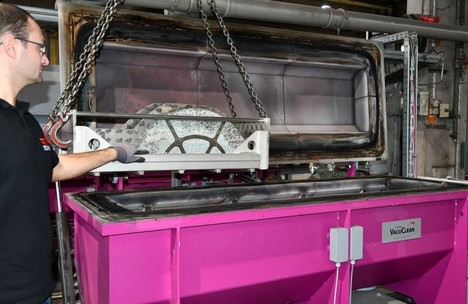Recycled PET (rPET) is increasingly being used for the production of fruit and vegetable trays: Circular packaging is the keyword here. Metal filters used in the production processes of large manufacturing plants have to be changed daily, sometimes multiple times per shift, and freed of rPET residues. "To clean these filters, our packaging customers use our particularly gentle and environmentally friendly vacuum pyrolysis technology," explains Virgilio Perez Guembe, thermal cleaning expert at SCHWING Technologies.
Unlike lengthy manual procedures, this fully automated process takes only about eight to ten hours. "Our VACUCLEAN systems clean quickly and in just one operation: This not only saves time, but also manpower," emphasizes Perez Guembe, pointing out that users also benefit from optimized digital networking of the systems.

Removing recycled PET from filters with thermal vacuum pyrolysis. Picture: SCHWING Technologies
Short cleaning times for rPET-contaminated filters
Examples for these applications are metal filters measuring approx. 85 x 35 cm (W x H), which are used in the production process of fruit and vegetable peelings. The producer, a Spanish packaging manufacturer, works with rPET. The company has to clean its filters on a daily basis and uses vacuum pyrolysis technology and SCHWING's special cleaning know-how for this purpose. Technical factors such as the individual cleaning duration, the vacuum atmosphere, the exact temperature curve and the maximum temperature of the entire process were specially adapted to the filter systems and rPET of this user. "In order to further accelerate the cleaning process, we also manufactured a loading basket for our customer that was specially adapted to the dimensions of the filters," the SCHWING expert reported.
Environmentally friendly cleaning process with the vacuum pyrolysis system
Cleaning is carried out in an electrically heated vacuum cleaning chamber, with temperatures measured directly at the filter. Perez Guembe describes the environmentally friendly cleaning process as follows: "To allow a large part of the rPET to first melt and flow out, the system heats up slowly and gently. Only at around 440 degrees Celsius does the actual pyrolysis process begin, which decomposes the remaining polymer. Any remaining carbon is removed by a subsequent oxidation phase at about 450 degrees Celsius. All this is done fully automatically and leaves almost no residue. The last inorganic residues are removed manually with compressed air if necessary."
Digital integration of the VACUCLEAN cleaning system
In order to digitally optimize the fully automatic cleaning process, the SCHWING development team has added several new components to the thermal vacuum pyrolysis system. These digital components include a new touch panel with network connection, an internal data connection for data mining and digital plant documentation in the SCHWING cloud. Other technical innovations include a fully electronic flow measurement for catalyst supply air, a process signal lamp and a revised fault message concept. "All these measures significantly reduce cleaning times, which is particularly important for our customers in the packaging industry," says Perez Guembe.
SCHWING Technologies GmbH

Oderstraße 7
47506 Neukirchen-Vluyn
T +49 2845 930 146
www.schwing-technologies.com
www.thermal-cleaning.com/de/reinigungs-systeme-und-zubehoer/vakuum-pyrolysesysteme.html
